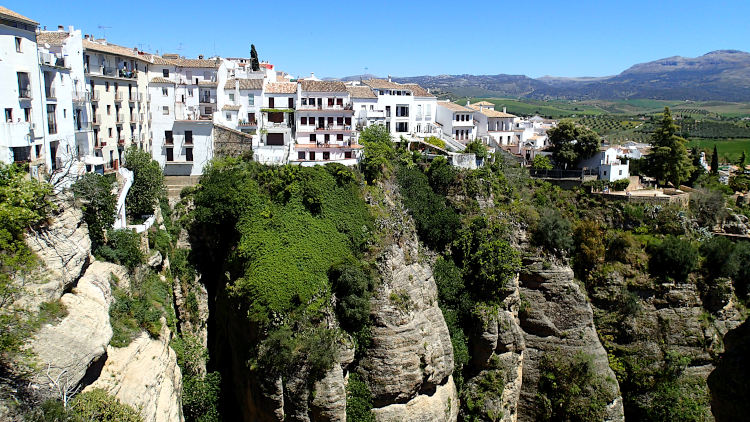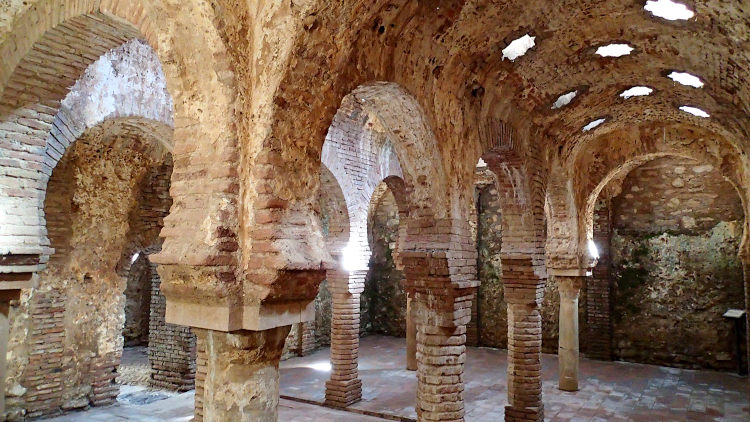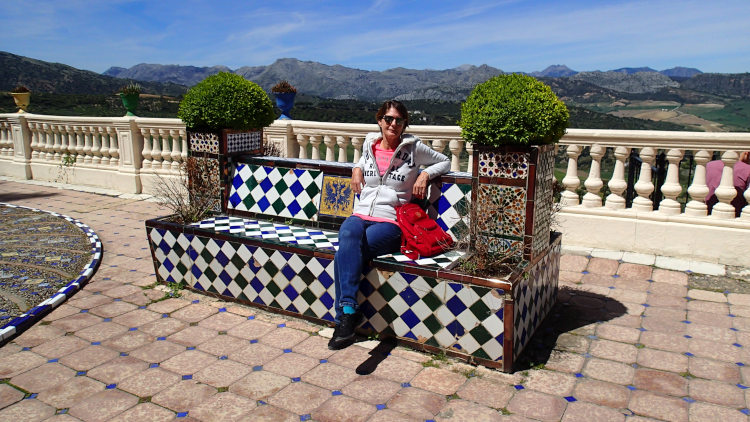Are you sure you want to go to Ronda, asked the hubby. It’s just a bridge. We could drive past, stop to take a photo and just keep on going. Or bypass it all together – you’ve seen the photos.

If you look at all the photos of Ronda you might think the same – it’s got a famous bridge and not much else. But if you skip Ronda on your trip you’ll be missing out on all the other things to do and see that make it a great 1-2 day stopover up in the hills.
The ‘campsite’ in Ronda
We usually pick our place to stay based on location and how easy it is to get into town, and how safe it looks to leave the motorhome and go out for the day without worrying. Cost is sometimes an issue – we prefer cheap or free to spending a lot of money when we don’t really use the campsite facilities.
In Ronda, they had the perfect spot for us. On the outskirts of town, easy road access in, with easy access into the tourist sites, and no fancy facilities we would pay for but not use. The official Area Autocaravanna has hardstanding, a washer and dryer, a sink, some EHU if you want to pay extra for them, a full motorhome service point – and an unmanned barrier so you just come and go when you like and pay for the parking time you stayed.
If you want to just drop in and use the services, you get 3 hours for €6.00. If you want to stay longer than 3 hours, then you pay €10 for the first 24 hours and then every extra 5 hours costs another €2. WIFI is included and is super-fast – the fastest we’ve had on any site by a long way. TIP – you can find the wifi password on the parking ticket you get from the entry barrier. Perfect.
Website / Park4Night / SearchForSites
You can find the site marked up with co-ordinates etc on our map and route page. Use the pop-out menu on the left of the map to pick our free or paid sites.
Our top recommendations for favorite must-see spots in Ronda
Firstly, walking and hiking. The tourist information office can help with some simply stunning hikes around this gorgeous area, of varying level of difficulty. When you look out from Ronda into the scenic countryside, it’s only natural you want to get out there for yourself. Enjoy!

If you want to enjoy walking around the town, there are plenty of parks, gardens, narrow cobbled streets and plazas to keep you occupied. We kept note of our route through the town over the couple of days, and we’d walked more than 10 miles and loved every step. Pick up a good map of the town with all of the historic sights listed from the Tourist Information office. Wear good shoes though, many of the streets are cobbled.
While you walk, you’ll come across various ‘miradors‘ dotted around the town and usually shown with a camera icon on the map. These are places where you can get some great photos, but we found all of the parks and gardens were fantastic for taking selfies with the gorge, the countryside or the bridge in the background. It’s a VERY picturesque place to visit. We took more than 300 photos in two days!

We recommend the Alameda Del Tajo gardens and the Mirador de Ronda in the Haruta Square Park, then take a walk around the edge of the gorge, past the Parador Hotel to another viewpoint of the bridge just before you cross. Once across, you can follow the road through the old town, out through the city walls and follow the Carretera de Los Molinos to get views up the gorge to the new bridge. Take a drink, this can be a hot walk on a sunny day and it’s quite a drag back up to the town from there.

We especially liked Jardins De Cuenca on the back side of the new bridge. Great place to sit on the wall and get someone to take your photo with the bridge in the background.
Of course, we should mention the bridge too. In fact, there are THREE bridges across the gorge here at Ronda, two now known as the old bridges which are much lower down within the town, and the one spectacular and huge ‘new bridge‘ which is the iconic image of Ronda in all the photos. This may be called the new bridge but it was actually started in 1759, taking 34 years to build. So it’s still a very old bridge.

The construction of the newest bridge (the one that stands today) was started in 1759 and took 34 years to build. There is a chamber above the central arch that was used for a variety of purposes, including as a prison. During the 1936-1939 civil war both sides allegedly used the prison as a torture chamber for captured opponents, killing some by throwing them from the windows to the rocks at the bottom of the El Tajo gorge. The chamber is entered through a square building that was once the guard-house. It now contains an exhibition describing the bridge’s history and construction.
Construction of the previous bridge started in 1735, this was the first attempt to span the gorge at this height and was completed by the architects Jose Garcia and Juan Camacho using a single arch design. Unfortunately, this bridge was quickly and poorly built and in 1741 the entire bridge collapsed resulting in the death of 50 people.
Wikipedia

The two older bridges are certainly worth a look and still beautiful although obviously not so imposing as the ‘new’ one. The walk down to them through the pretty whitewashed cobbled streets is a joy in itself. You’ll come to a large square with a huge water fountain with several running spouts on one side and a huge trough on the other side, next to the church. Then you turn the corner on the bottom right of the square and see the Old Bridge and it’s just perfect there.

The Arab bridge (built during the Moorish era) is the oldest and lowest down the river, then the Old Bridge (built 1616) comes above that. This bridge integrates seamlessly with the city walls. (Walk up on the right-hand side of the middle bridge and you’ll come to the Jardines mentioned above.)

Walk across the middle bridge, alongside the old restored city walls and gates, and follow the cobbled steps down towards the river. At the bottom, you’ll find the Arab Baths, perhaps some of the best preserved Moorish baths in Spain. Built around the 13th century, if you are familiar with ancient Roman Baths you’ll see how this design is very similar. With a hypocaust of underfloor heating, the baths included a hot steam room, a warm room for relaxing, massage and other cleansing treatments, a cold room with plunge pools, a large reception area for relaxing and socialising, and some gardens.

There is a very good 10-minute video presentation that runs automatically in Spanish and then in English. While we were there, it was very busy with visitors, but most came through on guided tours, all visited at once for 10 minutes in large numbers, then all left and we had the place almost to ourselves for a while until the next group arrived. So be patient, take the time to sit and enjoy and you’ll soon be able to get some snaps of the wonderful architecture of the baths without all the visitors. Entry was €3.50

There are also a number of museums and houses you can visit in Ronda. One of mention, the Casa Del Rey Moro was sadly closed for refurbishment works while we were there, but hopefully it will reopen soon. It sounds like it has fascinating water gardens and a series of steps down to the gorge through the rocks.

We enjoyed our visit to the Casa Don Bosco. A modern, early 20th-century grand house and garden built right on the edge of the gorge with amazing countryside views. It’s a large house and only a very small part is open to the public, but the cool and tiles courtyard is lovely, the views from the rooms are totally breathtaking and the pretty gardens with fountain and tiled benches is a delight.

A nice place to discreetly eat your packed lunch. Entry is just €2 and their gift shop has a fantastic selection of brightly colored tiles to take home as souvenirs.

The tourist information office highly recommended a visit to the Mondragon Palace and with a name like that, who wouldn’t want to check it out. We were not altogether excited however to find it was a museum of the history of man from the time of hunter-gatherer, to farming, house building, the stone age, metal ages, Romans etc. Although it may have been an interesting museum in itself, it wasn’t really relevant to the locale except for a few mentions here and there about how finds in the area showed it had been occupied through the ages. There are apparently some very impressive ancient cave paintings in the mountains surrounding the town.

It has a small garden, and some nice courtyards, and would have been a very impressive and large house in its day. If you are pressed for time, it wasn’t one of the highlights of the town for us. Entry was €3.50
We took a leisurely two days to visit, with lots of just wandering the cobbled streets, sitting in plazas and coffee shops and admiring all the wonderful mountain and countryside views. You could do most of the sites in one day, but why rush? The atmosphere here is relaxing, take your time, see it all.
Footnote – eating out
Stop for long lunch or a romantic evening meal. Ronda is jam-packed full with fantastic eateries, cafes and restaurants for all budgets whether you want to grab a McDonalds or eat at a Michelin star restaurant overlooking the gorge. Look here for the best-rated restaurants on Trip Adviser.
Just a few more pics from our visit to Ronda.











